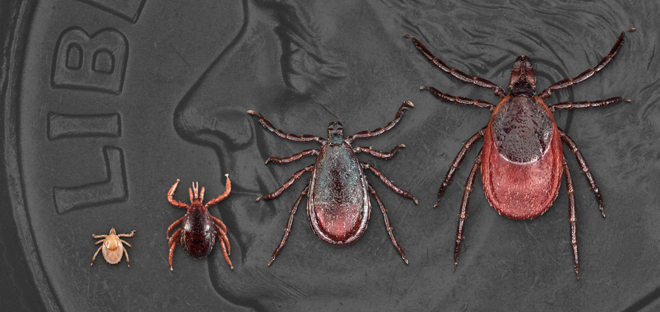There are more than 270 vaccines in the pipeline of big pharma. It seems that vaccination is the answer to every single issue we have!
For example, they are developing a vaccine to help people quit smoking!
This is just getting crazy and weird!
You may have heard that they have been working on a vaccine for Lyme.
I wonder sometimes if those doctors really spend time to think about what they are working on…
This vaccine will never work; it is totally BOGUS science!
First of all, this vaccine does not address that Lyme isn’t one unique pathogen Borrelia, but multiple buddy pathogens. Ignores babesia, Bartonella, mycoplasma, EBV, parasites, CMV, Rocky Mountain spotted fever, etc. which are coinfected with Borrelia from a tick – same tick carries most of them per field studies and per clinical cases (most are coinfected).
The vaccine premise totally ignores the huge problem of inevitable coinfections. It doesn’t address babesia, which almost always comes with borrelia and makes it harder to get rid of Lyme, nor Bartonella or other coinfections. Lyme is not one bug. Each coinfection on its own is a huge problem and can disable and eventually kill or kill by causing “complications.” If you can nail borrelia really early, it’s best (but medical schools aren’t teaching correct screening and diagnosis because they are beholden for most of their operating funds to industry R&D, so industry shapes their curriculum). And because the IDSA Lyme panel, who came out of early biowarfare studies and are paid by industry now, had purposely OMITTED key western blot bands for officially accepted public testing and they purposely set the least accurate test (ELISA titer for antibodies, which is only like 40-60% accurate and it’s for antibody traces which Lyme suppresses output of); this would benefit the industry in the long run but not the public.
Second, the “new” vaccine is a remake of the original vaccine premise, which failed (caused latent problems and Lyme increased with it).
Third, you can’t vaccinate against Lyme because local borrelia always has a hundred or more variants (most respond to same antibiotics though), so does babesia and Bartonella and the mycoplasmas, etc. that tend to come along with it. (Tick guts are a sewer).
Fourth, the vaccine is based on maybe two outer membranes (OSPA, OSPB, or whatever they chose) of only one or two variants of borrelia only. The premise is that it will trigger immune detection and defense. But nope. Borrelia has many local variant strains in most locations. And borrelia has MULTIPLE variants of its outer cell coat – like 5 or more; it just moves building blocks around depending upon host conditions, to evade immune detection. Yep, this bacterium is smart. It has multiple tricks in its sleeve to avoid the immune system. That is why those Lyme literate doctors can’t cure a Lyme patient with antibiotics.
Fifth, borrelia has flagella INSIDE a double membrane, so flagella-detecting biochemistry tests won’t detect it. This makes it harder to treat it using conventional medicine. Again, that is another reason why MDs can’t cure Lyme patients.
Sixth, Borrelia is a “keyhole” sort of pathogen because it weakens the immune system to other pathogens (that it travels with) by:
- suppressing B immune cells
- lowering thyroid or otherwise altering the endocrine system
- causing inflammation at a systemic level because THE CELL COAT IS COMPRISED OF FUNGAL ANTIGENS WHICH ARE THEMSELVES INFLAMMATORY, which is why you should AVOID the vaccine. It will stimulate inflammatory processes in many people which can trigger other latent problems (which are profitable to the industry but not you)
- and systemic inflammation raises cortisol which impedes serotonin/sleep
- Borrelia targets the antibody production that detects Borrelia and stops them from making the antibody (like shooting out the towers in a tower defense game). Again, making it difficult to get rid of it.
- Borrelia changes its outer cell coat proteins composition to hide from immune detection
- Borrelia sheds its cell coat completely and morphs into a little ball for living inside host cells
A vaccine needs to NOT stimulate latent things with being inherently inflammatory at the systemic cell levels, and it needs to address the common factors among borrelia AND babesia AND Bartonella AND mycoplasma AND all other co-infections.
It’s such a tall order since they are all different but come together in tick bites, that it would be better to look for some common factor instead.
It is now well-established that Borrelia organisms (and even the co-infections Babesia and Bartonella) are unlike many other kinds of microorganisms in that they are highly advanced in their lifecycle activities, survival capabilities, and ability to respond to environmental threats. Each year, approximately 30,000 cases of Lyme disease are reported to the CDC.
Lyme patients have a wide range of symptoms that are, unfortunately, not specific to Lyme, which makes it difficult to diagnose. Fever, dizziness, muscle and joint pain, and headaches are only a few of the possible things one could experience if they contract Lyme disease, according to the CDC.
In addition, a lot of patients with Lyme are being misdiagnosed with Alzheimer’s disease, ALS, autism, dementia, fibromyalgia, chronic fatigue, auto-immune disease, insomnia, seizure, mental disorders, thyroid issues, etc.
Lyme can be transmitted by ticks, mosquitoes, spiders, fleas, dogs, cats, intercourse, and some evidence, enough it is not conclusive, dust mites.
Lyme disease is very complex because this bacterium hides into the tissues and organs. It lives in the gut. As a matter of fact, some scientists believe it is actually a parasite, not a bacterium, which explains why antibiotics don’t help. As you can see, there is still a lot we do not know about Lyme. Researchers are confused about it.
Lyme hides in the gall bladder, liver, biofilms, it hides in nematodes, parasites, worms.
We know that these community members are larger than Borrelia, Bartonella, and Babesia, and we know that they play an important role in the Lyme complex. They are likely worms, or worm-like organisms, or even a number of different species of worm-like organisms. As it turns out, these larger worms or parasites have some surprising properties.
First, they can live outside the gut and throughout the rest of the body. Historically, worms and worm-like parasites were believed to be mostly confined to the gut. These new worms or parasites can take up residence with Borrelia, Babesia, and Bartonella, take shelter within biofilm communities and become important partners in the survival of the infections.
It now appears that many Lyme sufferers are infected with these newly acknowledged parasites, just like many Lyme sufferers carry co-infections. Furthermore, because of the symbiotic relationship between parasites and Lyme-related infections, without addressing parasites, overall progress in healing may be halted. Therefore, the topic of treating parasitic infections is hugely important. Ignoring it could cause your entire healing process to come to a halt.
Other than the co-infections, there is what I call the “opportunistic infections.” The combined effect of the initial infection is an immune suppressive effect, and then the patient becomes vulnerable to all sorts of other things.
The most common thing people contract early on in the course of the illness is different forms of parasites, such as protozoa; Babesia itself being one of them.
There is Giardia, amoebas, Trichomonas, malaria, and different forms of infections that aren’t labeled yet. There is a new one called FL1953. Stephen Frye discovered it. It’s a protozoan organism that’s causing severe fatigue and illness in chronically ill people. It’s almost always present in a patient with Lyme disease.
And then we find a lot of worms in people. They may be microscopic, and they may be macroscopic. That means they may be visible in the stool, or they may not be visible.”
They are three major factors we need to uncover to start the healing process: a) identify the organ (s) that have been affected by this micro-organism, b) identify and address the co-infectious micro-organisms, c) identify the nutritional deficiencies that are caused by this disease
Accumulation of mercury and other metals suppresses the immune system, which makes the body prone to a Lyme infection. That explains why some people develop full-blown Lyme as opposed to others who can get rid of it quickly.
Clinically,
parasites are the major cause of virtually every major illness. Regarding Lyme
disease, they are the primary co-infection of Lyme that underlies the severity
of the disease.
We know
that more than 70% of the immune system is located in the gut. As the primary
mechanism of defense, the immune system fights hard the presence of parasites
anywhere along the GI tract. As a consequence, the immune system shuts itself
down over time and cannot fight pathogens anymore.
Parasitic infections are often missed by Lyme-literate doctors who mostly focus more on the common tick-borne infections than other causes of symptoms. And if they identify parasites in a Lyme patient, they do not have the necessary tools to properly handle this situation to get rid of them once and for all.
Parasites can cause a diverse array of symptoms, including gastrointestinal problems, malabsorption, vertigo, skin rashes, fatigue, memory loss, brain fog, depression, allergies, pain, among others.
In other words, parasites can mimic symptoms of Lyme disease. Often time doctors are misled to believe that Lyme is the main problem, but in fact parasites are the actual underlying factor that contributes to the progression of the disease.
In the majority of cases, if not all, parasites can make the patients sicker than the Lyme infection by itself. It is therefore important to get rid of parasites and avoid contamination.
There is no doubt that Lyme is a complex and multi-faceted disease. Several factors have to be taken into account in order to come up with the proper treatment. The most important factor that we absolutely need to consider is the way of transmission and the co-infectious pathogens.
Some researchers have discovered that DNA from worms can be found in a bacterial biofilm community. This means that worms/parasites may be involved, to some degree, in the proliferation and survival of much smaller bacteria, such as Lyme bacteria.
In fact, it may be impossible to adequately treat Lyme disease without addressing this worm infestation. Thus, as you can see, parasitic treatment is the key when it comes to Lyme disease.
Anti-worm therapies help and are critical to destabilize the entire Lyme disease colonies located in deep tissue throughout the body. Indeed, we see that the use of anti-parasite herbs, for example, degrades the biofilm surrounding the Lyme bacteria colonies, which lead to the reversal of the Lyme symptoms.
Finally, it is believed that around 40% of American ticks transmit “nematodes,” which are parasites. Dr. Willi Burgdorferi, who discovered the Borrelia, found 30 types of microscopic worms in an adult tick, which might lead to conclude that if people are indeed infected with various types of parasites the treatment with just antibiotics is not going to clean the infection and may actually make things worse.
This certainly is the answer to why ill people relapse and cannot get completely cured. Those cases cataloged as “Chronic Lyme Disease” could be just cases of people who have parasitic infections not properly treated.
There is no specific test for Lyme. The average patient sees 5 doctors over a period of 2 years before being properly diagnosed.
One of the reasons is that 50% of the patients do not recall any rash, which doctors think is the first evidence of being infected with Lyme bacteria.
The other reason is that the common ELISA test that you receive at your doctor’s office misses about 35-50% of the time, the detection of Lyme.
Conventional medicine is lost when it comes to treating Lyme disease.
Currently, the big thing in the world of Lyme disease is all those doctors put their patients on disulfiram. It can treat problem drinking by creating an unpleasant reaction to alcohol. It’s used in recovery programs that include medical supervision and counseling. And they realized that it could help with Lyme.
Side effects can be debilitating like nauseas, vomiting, dizziness, mental/mood disorders, muscle weakness, trouble breathing, liver issues, etc.
So far, I have seen several cases of liver issues and neuropathy with people taking this medication for treating Lyme.
I do not understand how doctors believe that by using harsh medication like this one, it will fix the problem. Actually, it causes more!
As you can see, a vaccine against Lyme is plain ridiculous and gives false hope to the Lyme sufferers.
However, if you have Lyme or believe you have symptoms similar to Lyme, there is hope that you can be helped.
The key is to determine the extent of the situation by assessing the damage done to the body, by identifying the co-infections, viruses, bacteria, parasites, fungi, biofilms, heavy metals, etc. Once this is done, you have a much clearer picture of what is going on and what you need to do to tackle this infection.
After I don’t know how many rounds of antibiotics, I cured my Lyme using functional medicine. That is the only way to get rid of Lyme. Because functional medicine looks and considers the totality of the body, how the different parts work together.
That is why there is more doctors moving to do functional medicine.
God bless y’all 😊
Dr. Serge







